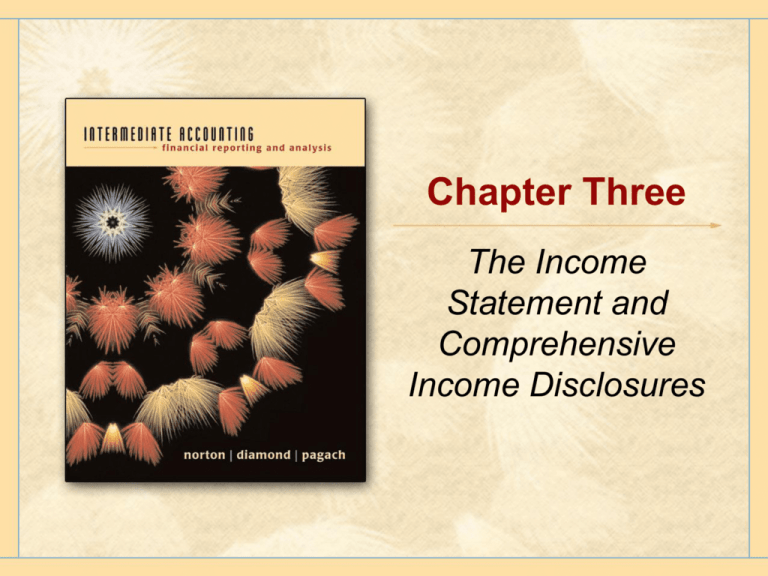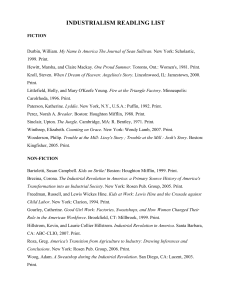
Chapter Three
The Income
Statement and
Comprehensive
Income Disclosures
What Is Income?
• One of the most meaningful figures that a
firm reports
• Significant measure of past performance
• Indicates potential for future prospects
• Relates to whether a firm is better off at
the end of a period than it was at the
beginning (apart from capital
contributions/withdrawals)
Copyright © Houghton Mifflin Company.All rights reserved.
3-2
Determining Net Income
Economic Approach:
Change in net wealth
due to a change in the
current value of an
asset
Copyright © Houghton Mifflin Company.All rights reserved.
Accounting Approach:
Net income derived from
business transactions
3-3
Critical Thinking
• Discussion: Consider how you measure
income in your personal finances. Do you
measure your income in relation to
specific transactions?
• If you measure your income in relation to
receipt of a paycheck or interest from your
bank, then you use a transaction-based,
or accounting approach.
Copyright © Houghton Mifflin Company.All rights reserved.
3-4
Accrual Accounting
• Foundation for determining net income
under GAAP
• Record transactions and events in the
period in which they occur rather than in
the period when cash or payment is
received or paid
• Based on matching principle and revenue
recognition principle
Copyright © Houghton Mifflin Company.All rights reserved.
3-5
The Income Statement
Provides information about the amount of
net income earned over a stated period of
time, detailing the revenues earned and the
expenses incurred
+ Revenues
- Expenses
+ Gains
Net Income
- Losses
Copyright © Houghton Mifflin Company.All rights reserved.
3-6
Income Statement:
Single-Step Format
• Revenues and gains in one category
• Expenses and losses in another category
• No distinction made between operating
activities and nonoperating activities
• Many variations on the single-step format
are used in practice
Copyright © Houghton Mifflin Company.All rights reserved.
3-7
Multiple-Step Income
Statement
Operating Section
•
•
•
•
Net sales
Cost of goods sold
Gross profit
Selling/administrative
expenses
• Other operating income
and expenses
Copyright © Houghton Mifflin Company.All rights reserved.
Nonoperating Section
• Net interest revenue or
expense
• Any other nonoperating
revenues and expenses
3-8
Items That Affect Net Income
• Recurring Items:
Transactions related
to ongoing operating
activities
• Sales
• Cost of sales
• Administrative
expenses
• Selling expense
• Gains/losses on
operating assets
Copyright © Houghton Mifflin Company.All rights reserved.
• Nonrecurring Items:
Transactions that are
unusual, infrequent,
or unrelated to
normal operations
• Discontinued
operations
• Extraordinary items
• Cumulative effect of
change in accounting
principle
3-9
Discontinued Operations
Presented separately
from income from
continuing operations
Copyright © Houghton Mifflin Company.All rights reserved.
3 - 10
What Constitutes a
Discontinued Operation?
• Segment of a business–a subsidiary,
division, or department whose assets are
clearly distinguished from the firm’s other
assets and operations, OR
• Component of an entity–operations and
cash flows that can be clearly
distinguished, operationally and for
financial reporting purposes, from the rest
of the entity
Copyright © Houghton Mifflin Company.All rights reserved.
3 - 11
Component of an Entity Being
Held for Sale (Or Sold)
• Qualifies as a discontinued operation if:
• Operations and cash flows of component will be (or
have been) eliminated from the ongoing operations of
the firm
• Entity will not have significant continuing involvement
in the operations of the component
• If component qualifies as a discontinued
operation:
• Report both revenues or losses from operations of
the component plus any gain or loss on its disposal
separately from income from continuing operations,
net of tax
Copyright © Houghton Mifflin Company.All rights reserved.
3 - 12
Extraordinary Items
• Unusual
• High degree of abnormality
• Unrelated to ordinary activities of the firm
• Infrequent
• Not expected to recur in the foreseeable
future given the nature of the firm’s
environment
• Material
• Large enough to make a difference in
investors’ decisions
Copyright © Houghton Mifflin Company.All rights reserved.
3 - 13
Accounting Changes
• A switch or change in accounting principle
that is either chosen by management or
mandated by the FASB or SEC
• A modification or change in an accounting
estimate
• The correction of an error, which, although
not technically an accounting change, is
treated in a similar manner
Copyright © Houghton Mifflin Company.All rights reserved.
3 - 14
Types of Accounting Changes
Copyright © Houghton Mifflin Company.All rights reserved.
3 - 15
Change in Accounting
Principle
• Cumulative effect of change on prior
years’ earnings reported net of tax after
income from continuing operations
• Effect of change on current year’s
earnings reported in continuing operations
• Carrying value of the asset or liability
associated with the change is recalculated
and adjusted
Copyright © Houghton Mifflin Company.All rights reserved.
3 - 16
Change in Accounting
Estimate
• If changing the estimated life of an asset
• Calculate new depreciation schedule
• Record new depreciation expense
incorporating the change in current period
• If revising the amount of uncollectible
accounts
• Make change in current period as an
adjustment to bad debt expense in ordinary
operating income
Copyright © Houghton Mifflin Company.All rights reserved.
3 - 17
Error Correction
• Illustration: Assume Angel Co.
neglected to record equipment
depreciation of $15,000 per year for the
past two years. Assume the company’s
tax rate is 35 percent. How is this error
corrected?
Retained Earnings [$30,000 x (1 - .35)]
Income Tax Refund Receivable ($30,000 x .35)
Accumulated Depreciation
Copyright © Houghton Mifflin Company.All rights reserved.
19,500
10,500
30,000
3 - 18
Intraperiod Tax Allocation
• The practice of relating income tax
expense to the specific item or event that
cause the tax
• On the income statement, report income
tax resulting from continuing operations as
a separate line. Report nonrecurring items
(discontinued operations, extraordinary
items, and cumulative effect of change in
accounting principle) net of their tax
effects
Copyright © Houghton Mifflin Company.All rights reserved.
3 - 19
Earnings Per Share
• The amount of earnings associated with
each share of common stock
Net Income-Preferred Stock Dividends
EPS =
Weighted-Average Number of Common Shares Outstanding
Copyright © Houghton Mifflin Company.All rights reserved.
3 - 20
Reporting Earnings Per Share
• Statement of Financial Accounting
Standards No. 128 requires that EPS be
reported for:
• Income from continuing operations
• Discontinued operations
• Extraordinary items
• Cumulative effects of a change in
accounting principle
• Net income
Copyright © Houghton Mifflin Company.All rights reserved.
3 - 21
Comprehensive Income
• Income resulting from transactions that
are primarily derived from events external
to the firm:
• Unrealized gains/loss on marketable
securities held in the available-for-sale
portfolio (Ch. 11)
• Unrealized gains/losses resulting from foreign
currency translations
• Amounts that result from recording the
minimum pension obligation (Ch. 15)
Copyright © Houghton Mifflin Company.All rights reserved.
3 - 22
Reporting Comprehensive
Income
• Components of comprehensive income
may be reported in one of the following
ways:
• One statement—net income and
comprehensive income are added together to
obtain total comprehensive income
• Two statements—net income reported on one
statement and comprehensive income
reported on another statement
• Report comprehensive income as part of the
statement of changes in stockholders’ equity
Copyright © Houghton Mifflin Company.All rights reserved.
3 - 23
Analyzing the Income
Statement
• Commonly used measurements:
•
•
•
•
•
Gross Profit
Gross Profit Percentage
Operating Margin
Operating Margin Percentage
Profit Margin on Sales
Copyright © Houghton Mifflin Company.All rights reserved.
3 - 24
Gross Profit
• Amount earned before operating
expenses
• Gross Profit = Net Sales – Cost of Sales
Dell Computer Corporation
Excerpt from Consolidated Statements of Income
Fiscal Year Ended January 1, 2003
(in millions)
Net revenue
Cost of revenue
Gross margin
Copyright © Houghton Mifflin Company.All rights reserved.
$35,404
29,055
6,349
3 - 25
Gross Profit Percentage
• Amount (expressed as percentage) of gross profit
earned on each dollar of sales
• Gross Profit Percentage = Gross Profit Net Sales
Dell Computer Corporation
Excerpt from Consolidated Statements of Income
Fiscal Year Ended January 1, 2003
(in millions)
Net revenue
Cost of revenue
Gross margin
$35,404
29,055
6,349
$6,349 million $35,404 million=
17.93 percent
Copyright © Houghton Mifflin Company.All rights reserved.
3 - 26
Operating Margin
• Amount the firm generates after operating
expenses and cost of sales (also called operating
income)
• Net Sales – (Cost of Sales + Operating Expenses)
Dell Computer Corporation
Excerpt from Consolidated Statements of Income
Fiscal Year Ended January 1, 2003
(in millions)
Net revenue
Cost of revenue
Gross margin
Total operating expenses
Operating income
Copyright © Houghton Mifflin Company.All rights reserved.
$35,404
29,055
6,349
3,505
2,844
3 - 27
Operating Margin Percentage
• Indicates how much operating margin is
generated on each dollar of sales
• Operating Margin Net Sales
Dell Computer Corporation
Consolidated Statements of Income
Fiscal Year Ended January 1, 2003
(in millions)
Net revenue
Cost of revenue
Gross margin
Total operating expenses
Operating income
Copyright © Houghton Mifflin Company.All rights reserved.
$2,844 million $35,404 million =
8.03 percent
$35,404
29,055
6,349
3,505
2,844
3 - 28
Profit Margin on Sales
• Amount of net income earned on each
dollar of sales
• Net Income Net Sales
Dell Computer Corporation
Year Ended January 31, 2003
$2,122 million $35,404 million = 5.99 percent
Copyright © Houghton Mifflin Company.All rights reserved.
3 - 29
Check Your Understanding
Q What is accrual accounting?
A Accrual accounting dictates that
transactions and other events and
circumstances are recorded in the period
in which they occur rather than in the
period in which cash or some other form
of payment is received or paid.
Copyright © Houghton Mifflin Company.All rights reserved.
3 - 30
Check Your Understanding
Q If your company prefers to separate
operating from nonoperating activities on
its income statement, which format would
be used?
A The multiple-step format divides operating
from nonoperating items.
Copyright © Houghton Mifflin Company.All rights reserved.
3 - 31
Check Your Understanding
Q What are the three characteristics that
define an extraordinary item?
A Extraordinary items are unusual,
infrequent, and material.
Copyright © Houghton Mifflin Company.All rights reserved.
3 - 32
Check Your Understanding
Q How do you determine whether a
component of an entity that is being held
for sale can be considered a discontinued
operation?
A
The component can be considered a
discontinued operation:
(1) if the operations and cash flows of the component
will be eliminated from the ongoing operations of the
entity, and
(2) the entity will not have any significant continuing
involvement in the operations of the component.
Copyright © Houghton Mifflin Company.All rights reserved.
3 - 33
Check Your Understanding
Q If a change has been made to an
accounting estimate, how is this change
reflected on the income statement?
A The cumulative effect of the change on
prior years’ earnings is reported net of tax
after income from continuing operations.
The effect of the change on the current
year’s earnings are reported in continuing
operations.
Copyright © Houghton Mifflin Company.All rights reserved.
3 - 34
Check Your Understanding
Q Why is EPS an important measurement to
investors and analysts?
A EPS indicates, on a per share basis, the
income of the current period for both the
recurring and the nonrecurring items that
are associated with the common
shareholders’ ownership interest.
Copyright © Houghton Mifflin Company.All rights reserved.
3 - 35
Check Your Understanding
Q List items that would be considered
nonrecurring on the income statement.
A Discontinued operations, extraordinary
itmes, and the cumulative effect of a
change in accounting principle would be
considered nonrecurring items.
Copyright © Houghton Mifflin Company.All rights reserved.
3 - 36





